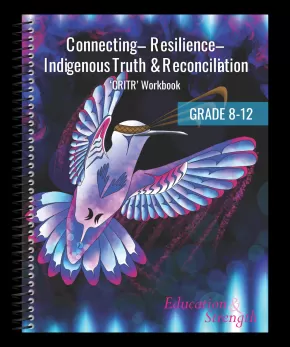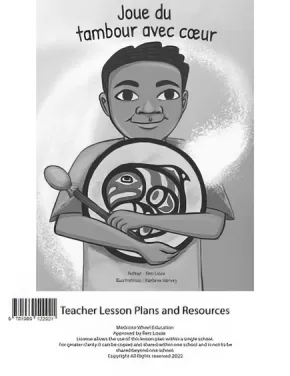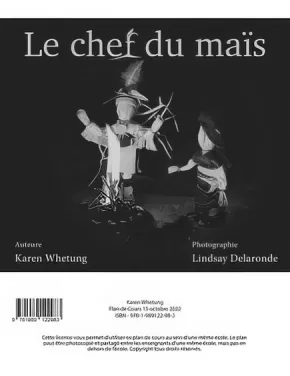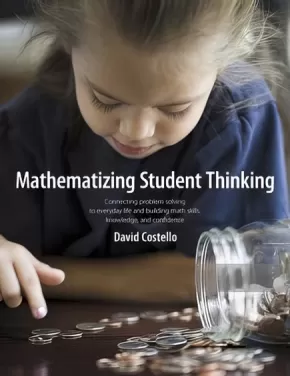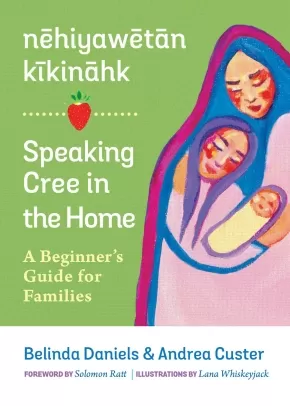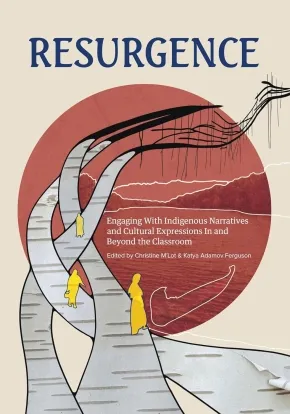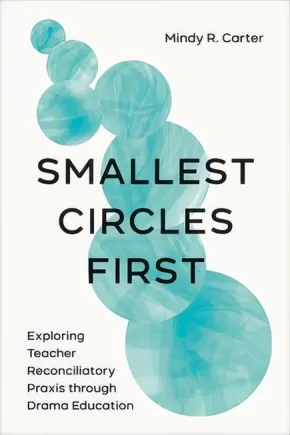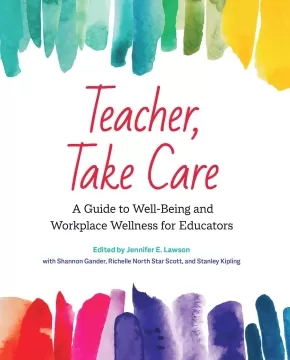
Educator Resources
46
-
60
of
213 Results;
Sort By
Go To
of 15
Connecting – Resilience – Indigenous Truth & Reconciliation ‘CRITR’ Workbook: Grade 8 - 12
$29.95
Artists:
Format:
Coil Bound
Text Content Territories:
Indigenous Canadian; First Nations; Inuit; Métis;
ISBN / Barcode: 9781990448355
Synopsis:
Synopsis:
CRITR provides dozens of lessons and 100s of questions covering important topics including: Indigenous Canadian History, Residential Schools, Indigenous Contributions past and present, Treaties, and Indigenous Days of Recognition in Canada.
This book is a collection of parts of the history of the Indigenous Peoples in Canada and of the process of reconciliation. It is designed to educate all children and youth -- our future leaders -- about Indigenous history and current events. It is intended to give a better understanding and to positively contribute to reconciliation.
Together, we must consider the past, the present, and the future in our efforts to better ourselves and future generations.
This book provides a wealth of high-quality articles and learning activities, consisting of units and lessons that can be used by anyone -- teachers, parents, students, business professionals -- who may have little or no prior knowledge or understanding of Indigenous Peoples or subjects.
In this book, you will meet real Indigenous Peoples speaking out and sharing their stories and their firsthand experiences, and you will clearly hear their passion for reconciliation.
This book is unique. The stories told within its covers are unique, just like everyone working through their own journey of understanding and doing their small part towards reconciliation.
“We need to pursue reconciliation consistently and passionately. Education has gotten us into this mess, and education will get us out. We see this as our challenge and our hope.” -The Honourable Senator Murray Sinclair
Educator Information
Recommended for grades 8 to 12.
CRITR Workbook Features
- Indigenous knowledge from different Indigenous Peoples and Indigenous perspectives.
- Dozens of lessons covering important topics including Residential Schools, Treaties, and Indigenous Contributions.
- Beautiful original art on the cover and throughout the book.
- An Indigenous worldview expressing people's need to develop themselves and their children, in a way that addresses their spiritual, physical, emotional, and mental gifts.
- An approach to the teaching and healing process that is interconnected and cyclical in nature.
- An introduction to readers of the concept of a "sacred circle," also known as a medicine wheel, as well as First Peoples' principles of learning in general terms.
- Words of encouragement.
- A balance between too much and too little content.
- Information and a layout to inform and inspire without overwhelming the teacher or the student, in the classroom or at home.
- Fresh insights and learning activities for key Indigenous events that are celebrated annually in schools and communities across the Nation.
- Critical thinking questions to inspire new learning.
- Activities for individuals and groups.
- Grade-level appropriate word choices to help with improved vocabulary.
How is the CRITR workbook organized?
Each lesson follows this pattern:
- An easy-to-read lesson that may be read in under 5 minutes
- A vocabulary focus called Word Power that defines key words from the lesson
- A set of questions easily answered from the reading
- A Critical Thinking section is included to enhance learning
- Sprinkled throughout the CRITR Workbook are relevant individual and group activity recommendations.
Additional resources are identified throughout the pages with links, including information about how to connect with the Indigenous authors and artists.
Activities, colouring, and word search pages may be downloaded for free. An answer key is included at the end of the book.
What will students learn from this resource?
- Reconciliation is about change, justice, respect, and re-building the relationships between the Indigenous and non-Indigenous Peoples in Canada
- Indigenous History of Canada
- Empathy that comes from understanding and being educated
- Knowledge about important and sensitive topics, including stories told by Indigenous authors about what occurred at residential schools. It is important to know these stories of assimilation
- Capacity for intercultural understanding, empathy, and mutual respect as prescribed specifically in CTA #63
Educator Information
Recommended for grades 5 to 12.
A $5 per book discount is applied to a purchase of 10 or more books.
This book is available in French: Connexion - Résilience - Vérité et réconciliation autochtones Ressource - 8e à 12e année
Additional Information
188 Pages | 9" x 11.5" x 0.5" | Spiral Bound
Drum from the Heart Teacher Lesson Plan
$7.99
Format:
Paperback
Text Content Territories:
Indigenous Canadian; First Nations; Nuu-chah-nulth (Nootka);
ISBN / Barcode: 9781989122891
Synopsis:
Synopsis:
Teacher lesson plan that accompanies the book, Drum from the Heart. When he is gifted a handmade drum by his mother, Ren learns the teachings of the drum that she also passes down to him. Ren discovers that through this special drum, he is able to connect to his culture and find a confidence in his voice to joyfully share in singing the traditional songs of his Nuu-chah-nulth Nation.
Educator Information
Geared towards students up to grade 5. Includes comprehension questions, a section on how to make your own drum, and more.
Created by an Indigenous educator at Medicine Wheel Publishing with full approval from the author.
Highlights Indigenous perspectives and knowledge.
Find the student resource HERE!
This resource is available in French: Joue du tambour avec coeur plan de cours
Additional Information
12 pages | 8.50" x 11.00" | Paper Packet
Heartbeat of the Earth: A Handbook on Connecting Children to Nature through Indigenous Teachings
$47.75
Artists:
Format:
Paperback
Text Content Territories:
Indigenous Canadian;
ISBN / Barcode: 9781778258701
Synopsis:
Synopsis:
Nature is a place to both play and learn. The physical self is moving and active, the mental self is thinking and questioning, the emotional self is feeling and experiencing, and the spiritual self is connecting and thankful. We see what we have been taught to see. We love and respect our natural surroundings when we see ourselves as belonging to that community. This resource leads readers on a rich learning journey as they deepen their connections to nature and culture.
The activities inside instill traditional teachings of respect, honour, resourcefulness, and humility in children. This handbook is intended to inspire parents, caregivers, and educators to provide children with meaningful outdoor experiences interwoven with traditional indigenous knowledge.
Educator Information
For use with children.
Table of Contents
Introduction
The Power of Ceremony
- Introduction
- Ceremony and Daily Life
- Sunrise Ceremony
- Nature Picnic
- Sharing
- Navajo Forgiveness Ceremony
- Smudging Ceremony
Mindfulness: Meditation of Gratitude
- Introduction
- Gratitude
- Silent Study
- Sensory Wake-Up
- Walking Meditation
- Guided Meditation
- Nature Meditation
- Traditional Prayers
We Are All Related
- Honouring the Plants, Earth and Water
- Medicine Wheel Teachings in Nature
- Water is Life
- Find the Rock Game
- Adopt a Tree
- Read a Tree
- Earthing
- Build a Nature Structure
Swimmers, Walkers and Fliers
- The Animal People
- Walk Like the Animal People
- Tracking
Indigenous Games
- Introduction
- Blindfold Detective
- Stalk the Drum
- Fire Keeper
- Deer Cliff Arrow
- Hunter
- Run and Scream
- Metis Map-Making
Conclusion
Additional Information
84 pages | 9.00" x 7.00" | Paperback
Joue du tambour avec coeur plan de cours (LP)
$7.99
Format:
Paperback
Text Content Territories:
Indigenous Canadian; First Nations; Nuu-chah-nulth (Nootka);
ISBN / Barcode: 9781989122921
Synopsis:
Synopsis:
Plan de cours de l'enseignant qui accompagne le livre Joue du tambour avec coeur. Quand sa mère lui donne un tambour fait à la main en cadeau, Ren apprend les enseignements du tambour qu’on lui transmet par le fait même. Il découvre que, grâce à ce tambour spécial, il peut créer des liens avec sa culture et reprendre confiance en sa voix pour partager avec joie les chansons traditionnelles de sa nation, la Nation Nuu-chah-nulth.
Educator Information
Find the student resource here: Joue du tambour avec coeur
This resource is available in English: Drum from the Heart Teacher Lesson Plan
Additional Information
14 pages | 8.50" x 11.00" | Paper Packet
Kaandossiwin: How We Come to Know: Indigenous Re-Search Methodologies - 2nd Edition
$32.00
Format:
Paperback
Text Content Territories:
Indigenous Canadian; First Nations; Anishinaabeg;
Grade Levels: University/College;
ISBN / Barcode: 9781773635170
Synopsis:
Synopsis:
Indigenous methodologies have been silenced and obscured by the Western scientific means of knowledge production. In a challenge to this colonialist rejection of Indigenous knowledge, Anishinaabe re-searcher Kathleen Absolon describes how Indigenous re-searchers re-theorize and re-create methodologies. Indigenous knowledge resurgence is being informed by taking a second look at how re-search is grounded. Absolon consciously adds an emphasis on re with a hyphen as a process of recovery of Kaandossiwin and Indigenous re-search. Understanding Indigenous methodologies as guided by Indigenous paradigms, worldviews, principles, processes and contexts, Absolon argues that they are wholistic, relational, inter-relational and interdependent with Indigenous philosophies, beliefs and ways of life. In exploring the ways Indigenous re-searchers use Indigenous methodologies within mainstream academia, Kaandossiwin renders these methods visible and helps to guard other ways of knowing from colonial repression. This second edition features the author’s reflections on her decade of re-search and teaching experience since the last edition, celebrating the most common student questions, concerns, and revelations.
Educator Information
Table of Contents
Part One: Preparation For The Search
1) An Introduction to Preparing for Re-Search: Having Tea & Bannock
Re-storying and restoring location
Restoring self: Locating My Self
Decolonizing and Indigenizing My Re-search
Language and Terminology
Chapter Outlines
2) Indigenous Re-Search: Past, Present and Future
Indigenous Peoples’ Cultural History and Research
Oral Traditions and Narrative
Indigenous Knowledge Resurgence: Shifting Landscapes
Trailblazers: Re-searchers and their Searches
3) Colonial Research Trauma My Own Search: A Journey of Making Meaning
4) The Search Trail and Pathway
Part Two: Wholistic Re-Search Methodologies
5) Wholistic Worldviews and Methodologies
6) The Roots: Paradigms, Worldviews and Principles
Paradigms and Worldviews
Principles
7) The Flower Centre: Self as Central
Self
Location
Situate Self in the Search
Memory
Motive and Purpose
Search for Congruency
8) The Leaves: The Methodological Journey
An Organic Process
Travelling
Transformation
Healing
9) The Stem: Backbone and Supports
Critical Consciousness
The Role of Critically Conscious Indigenous Scholars
Indigenous Searchers’ Strengths and Supports
10) The Petals: Diverse Methodologies
Spirit: Protocols, Ceremony and Honour
Heart: Relationships, Reciprocity and Community
Mind: Respecting Indigenous Knowledge
Body: Doing, Working and Creating
11) The Enviro-Academic Context
Fences and Gatekeepers
Allied Theories
The Committee
Writing Oral Traditions and Other Ironies
Thorny Prickly Challenges
12) Indigenist Re-Search Projects and Methodologies: The Last 10 Years
13) Leaving Good Footprints and Winding Down
Additional Information
304 pages | 6.00" x 9.00" | Paperback | 2nd Edition
Le chef du mais plan de cours (LP)
$7.95
Format:
Paperback
Text Content Territories:
Indigenous Canadian;
ISBN / Barcode: 9781989122983
Synopsis:
Synopsis:
Plan de cours de l'enseignant qui accompagne le livre Le chef du maïs. Le sage vieux chef devrait bientôt laisser sa place et la jeune Linny rêve d'être choisie pour le remplacer. Alors qu'elle a de la difficulté à passer le test, Linny apprend, de la façon la plus inattendue et avec l'aide de sa famille, ce qu'il faut vraiment pour devenir chef…
Educator Information
Find the French student resource here: Le chef du mais
This lesson plan is also available in English: The Corn Chief Teacher Lesson Plan
Additional Information
12 pages | 8.50" x 11.00" | Paper Packet
Leading Through Spirals of Inquiry: For Equity and Quality
$31.00
Format:
Paperback
ISBN / Barcode: 9781774920206
Synopsis:
Synopsis:
Experienced educators Judy Halbert and Linda Kaser expand on their previous work in this all-new book for school leadership teams. Written for teams ready to get started—or keen to go deeper—this book will provoke new thinking and provide specific strategies for accelerating meaningful change.
Leading Through Spirals of Inquiry walks the reader through the six stages of the Spiral of Inquiry, a proven framework to help you
- overcome inequality to create genuine equity and change outcomes for students;
- transform learning environments at both the school and district level;
- clarify the direction for new professional learning based on evidence from educational research as well as real-world examples of innovative practices from other schools;
- challenge long-held biases and assumptions guided by clarity of purpose, a growth mindset, and a stance of curiosity;
- effectively incorporate self-reflection and continuous improvement in your learning environments.
Building on the experiences and wisdom of inquiry leaders from around the world, this book provides support for the specific issues leaders face during the process of change, as well as ways to engage in and support inquiry networks across schools, districts, and other jurisdictions.
Reviews
"If Leading Through Spirals of Inquiry were required reading for every education leader, school systems and the world would be a much better place. Judy Halbert and Linda Kaser invite readers to journey with them as they examine how adults can help every child “cross the stage with dignity, purpose, and options.” This book is at once a practical guide for school personnel and a manifesto on how to transform, and leapfrog forward, our education systems."— Rebecca Winthrop, Senior Fellow and Co-Director, Center for Universal Education, The Brookings Institution
"Judy Halbert and Linda Kaser’s Spiral of Inquiry framework reflects the importance of relationships, curiosity, trust, examination of biases and assumptions, and high expectations of both learners and ourselves. Embedded in this work is the understanding that Indigenous knowledge systems have positive impacts on learning environments, and that quality education systems require equity for Indigenous learners. I look forward to more educators engaging in this powerful and accessible inquiry process for the benefit of both learners and our larger society."— Jo Chrona, Author of Wayi Wah! Indigenous Pedagogies: An Act for Reconciliation and Indigenous Education
Additional Information
224 pages | 7.00" x 9.00" | Paperback
Mathematizing Student Thinking: Connecting Problem Solving to Everyday Life and Building Capable and Confident Math Learners
$32.95
Format:
Paperback
ISBN / Barcode: 9781551383569
Synopsis:
Synopsis:
How can you broaden student thinking and help them develop their independence and confidence as problem solvers? Real-life problems are a remarkable tool to stretch student thinking and help them develop a deeper understanding of mathematics and its role in everyday life. Rather than using textbook exercises, the book argues that solving real-world problems promotes flexibility and encourages students to adjust and grow their thinking. It inspires them to consider alternatives and apply math in authentic contexts. You will find practical ways to engage students in critical thinking, develop their independence, and make connections with the world.
Additional Information
160 pages | 8.30" x 10.88" | Paperback
nēhiyawētān kīkināhk / Speaking Cree in the Home
$19.95
Artists:
Format:
Paperback
Text Content Territories:
Indigenous Canadian; First Nations; Cree (Nehiyawak);
Reading Level: N/A
ISBN / Barcode: 9780889779006
Synopsis:
Synopsis:
A hands-on guide for parents and caregivers to develop best practices in revitalizing and teaching Cree to young children.
In nēhiyawētān kīkināhk / Speaking Cree in the Home, Belinda Daniels and Andrea Custer provide an introductory text to help families immerse themselves, their children, and their homes in nēhiyawēwin—the Cree language.
Despite the colonial attacks on Cree culture, language, and peoples, Custer and Daniels remind readers that the traditional ways of knowing and transferring knowledge to younger generations have not been lost and can be revived in the home, around the table, every day.
nēhiyawētān kīkināhk / Speaking Cree in the Home is an approachable, hands-on manual that helps to re-forge connections between identity, language, family, and community—by centering Indigenous knowledge and providing Cree learners and speakers with a practical guide to begin their own journey of reclaiming and revitalizing Cree in the home.
Readers are guided through methods for language learning, the basics of reading Cree and Standard Roman Orthography, pronunciation of vowels, engaging language-learning games, and examples of high-frequency words and phrases that can easily be incorporated into daily routines and taught to children young and old.
Reviews
“This is a welcome book for all who are interested in learning the Cree language, either for themselves alone or for themselves and their families. The book offers good guidance on the best practices in language learning based on the authors’ personal experiences in their respective language journeys.” —Solomon Ratt, author of mâci-nêhiyawêwin / Beginning Cree
“A major contribution, this book will be a useful resource in Cree classes, at both high school and university levels. But it is also useful for home use, as it describes the practical application of speaking Cree in the home and provides in an easy-to-read format and details a hands-on approach too.” —Dorothy Thunder (Plains Cree, Little Pine First Nation), Faculty of Native Studies, University of Alberta
“The activity-based learning lessons that are presented here should serve as a model not only for teaching the language in a family setting, but in any other formal and informal settings, because they cover all aspects of teaching and learning; the content, variety of methods, appropriate timing and setting. . . . The pioneering in Cree language acquisition and revival has begun and hopefully this book reaches all interested individuals.” —Ken Paupanekis, author of Pocket Cree: A Phrasebook for Nearly All Occasions
Additional Information
122 pages | 4.72" x 7.27" | Paperback
Resurgence: Engaging With Indigenous Narratives and Cultural Expressions In and Beyond the Classroom
$32.00
Editors:
Format:
Paperback
Text Content Territories:
Indigenous Canadian;
ISBN / Barcode: 9781774920008
Synopsis:
Synopsis:
A thoughtful guide to critical engagement with Indigenous literatures, perspectives, and teaching methods as well as ideas and action steps for bringing them into the classroom.
Resurgence is an inspiring collection of contemporary Indigenous poetry, art, and narratives that guides teachers in bridging existing K–12 curricula with Indigenous voices and pedagogies. Walk with us along the footbridge which seeks to:
- connect peoples and places
- link truth and reconciliation as ongoing processes
- symbolize the risk and urgency of this work for both Indigenous and settler educators
- engage tensions
- highlight the importance of balance, both of ideas and within ourselves
Through critical engagement with the texts, experienced educators Christine M’Lot and Katya Adamov Ferguson support readers in connecting with Indigenous narratives and perspectives, bringing Indigenous works in their classrooms, and creating more equitable and sustainable teaching practices.
In this resource, you will find
- diverse Indigenous voices, perspectives, and art forms from all across Turtle Island
- valuable concepts and methods that can be applied to the classroom and beyond
- practical action steps and resources for educators, parents, librarians, and administrators
Use this book as a springboard for your own learning journey or as a lively prompt for dialogue within your professional learning community.
Reviews
"Over the past several years, calls have come from across Canada for the inclusion of Indigenous worldviews and knowledge in all levels of education in the country. Enter...Resurgence." ––Windspeaker
Educator & Series Information
For use with K-12 curricula.
Contributors include KC Adams, Charlene Bearhead, Wilson Bearhead, Lisa Boivin, Nicola Campbell, Sara Florence Davidson, David A. Robertson, and Christina Lavalley Ruddy, and more!
Subjects / Themes: Education; Professional Development; Social Science; Indigenous Studies; Language Arts Disciplines; Study Teaching
This book is part of The Footbridge Series. This series aims to bridge curricular outcomes with Indigenous-centered content and perspectives from across Turtle Island. Like a footbridge, this series is intended to provide a path between Indigenous worldviews and the classroom, engaging differences, including tensions, and highlighting the importance of balance, all while helping teachers integrate Indigenous perspectives into multiple disciplines within the K-12 education system.
Table of Contents
Introduction
About This Book
About The Footbridge Series
Part 1: Resistance
Beyond Being Silenced by Sara Florence Davidson
- Connections
Poetry as Cultural Expression by Rita Bouvier
- Connections
T’seka Reflection by Lucy Hemphill
- Connections
Poetry by Louise Bernice Halfe
- Connections
Part 2: Resilience
Mental Health by David A. Robertson
- Connections
Writing as a Therapeutic Medium by Wanda John-Kehewin
- Connections
Birch Bark Technology by KC Adams
- Connections
Images and Health by Lisa Boivin
- Connections
Part 3: Restoring
Stories are Resurgence by Wilson Bearhead and Charlene Bearhead
- Connections
Why am I not on Star Trek? by Sonya Ballantyne
- Connections
Indigenous Spaces by Reanna Merasty
- Connections
Games as Resurgence by Elizabeth LaPensée
- Connections
Part 4: Reconnecting
Poems by Nicola I. Campbell
- Connections
Paths of Tradition by Russell Wallace
- Connections
Let the Children Play by Victoria McIntosh
- Connections
Ethnomathematics and Beading by Christina Ruddy
- Connections
The Contributors
Additional Resources
Index
Additional Information
224 pages | 7.00" x 10.00" | Paperback
Righting Canada's Wrongs: The Sixties Scoop and the Stolen Lives of Indigenous Children
$34.95
Format:
Hardcover
Text Content Territories:
Indigenous Canadian;
ISBN / Barcode: 9781459416697
Synopsis:
Synopsis:
This book for students examines a child welfare policy in Canada that began in 1951 in which Indigenous children were taken from their homes and put into the care of non-Indigenous families. These children grew up without their birth families, cultural roots and language. Many tried to run away and some died in the attempt. The taking of the children became known as the Sixties Scoop. The term “Sixties Scoop” makes explicit reference to the 1960s, but the policies and practices started before the 1960s and lasted long after. Today, Indigenous children are over-represented in the Child Welfare System across Canada in shocking numbers.
Indigenous communities got organized and fought back for their children. In 1985, the Kimelman Report was released, condemning the practice of adopting Indigenous children into non-Indigenous families and for taking so many children out of their communities.
In the 1990s, lawsuits were filed against the governments who had supported taking the children. In 2018 and 2019, Alberta, Saskatchewan and Manitoba apologized for their roles in supporting the adoption programs. In 2020, the Canadian government agreed to a settlement for survivors of the Scoop.
Through hundreds of photos and primary documents, readers will meet many survivors of the Scoop. They’ll also learn how Indigenous communities fought back to save their children and won, and how Indigenous communities across Canada are working towards healing today.
Educator & Series Information
This book is part of the Righting Canada's Wrongs series.
Recommended for ages 13 to 18.
This book is available in French: La rafle des années 1960: et enfance volée aux jeunes Autochtones.
Additional Information
104 pages | 9.01" x 11.02" | 300 Photographs | Hardcover
Smallest Circles First: Exploring Teacher Reconciliatory Praxis through Drama Education
$36.95
Format:
Paperback
Text Content Territories:
Indigenous Canadian;
ISBN / Barcode: 9781487523831
Synopsis:
Synopsis:
Drawing from studies with pre- and in-service teachers in Quebec, Smallest Circles First looks at how teacher agency engages with the educational calls to action from Canada’s Truth and Reconciliation Commission. Using drama education and theatre, Smallest Circles First explores how the classroom can be used as a liminal educational site to participate in reconciliatory praxis.
Smallest Circles First presents several arts-based educational research examples that illustrate how the arts provide a space for students, teachers, and communities to explore and learn about reconciliation praxis and responsibilities. By implementing arts-based counter-narratives set against settler Canadian history and geography, Smallest Circles First considers the implications of systemic racism, colonization, and political, social, and economic ramifications of governmental policies. Tangible examples from the book showcase how teachers and students can use the arts to learn specifically about their responsibilities in engaging with Canada’s Truth and Reconciliation Commission, in addition to how this work can still meet curricular learning outcomes.
Reviews
"A contribution to the fields of education and performing arts, Smallest Circles First is an excellent example of what can be done and what needs to be done in regards to building a shared future for all Canadians. Readers will feel empathic and identified with these narratives; not just the narratives of the author but also with the narratives of the participants in the research." — Maria del Carmen Rodriguez de France, Assistant Professor of Indigenous Education, University of Victoria
"The research and writing found in Smallest Circles First advances the calls to action in the TRC – in ways that allow space for exploration and in ways that do not insist that there is one ‘true’ way to do the work of reconciliation. This book is as much about hope as it is deep and instructive." — Michele Sorensen, Assistant Professor in the Faculty of Social Work, University of Regina
"Carter’s book provides insightful ways of engaging respectfully and meaningfully with Indigenous topics through drama-based approaches. She describes the work in a way that is thoughtful, ethical, and well grounded. The case studies in Smallest Circles First are diverse and dynamic, and they come together in ways that allow the reader to see the cohesive nature of the book." — George Belliveau, Professor and Head of Language and Literacy Education, University of British Columbia
"Smallest Circles First is a must for any artist or educator, providing research-based evidence of the role theatre can play in healing and reconciliation; her reframing of risk as the grounds for creative rupture is an important corrective to the risk-avoidant perspectives that dominate research and education." — Sheila Christie, Associate Professor of English and Drama, Cape Breton University
Educator Information
Table of Contents
Foreword by Tom Dearhouse
1.Starting with the Smallest Circles First
Teacher Agency, Canada’s Truth and Reconciliation Commission, and the Arts Curriculum
Language, Culture, and Religion in Quebec Education
Are the Arts the Answer?
Vignettes
About This Book
2. Walk a Mile in Someone Else’s Shoes: Situating Theories and Methods
Identity, Subjectivity, and Posthumanism
Arts-Based Educational Research (ABER)
Narrative Inquiry
Vignettes and Constant Comparison for Data Analysis
Making Sense of the Data, Saturation, and Validity
3. We Start Here: Narratives, Vignettes, and Analysis
Narratives
Monologue: I’m Still Canadian, Dad!
Appropriation and Embodiment
Centring Oneself within a Community of Practice
Discussion
4. Weaving Together Understandings across Vignettes
Theme 1: Risk and Learning as Rupture
Theme 2: Belonging
Theme 3: Counter-narratives
5. Full circle
Unfolding’s
Towards an Instructional Model for Belonging and Becoming by Learning through/with Drama
Learning Responsibilities
New Directions: Learning beyond the arts
Coming full Circle
Appendices
Appendix 1: Sing the Brave Song: This Isn’t Over!
Appendix 2: Reconciliation!
Appendix 3: Monologue: I’m Still Canadian, Dad!
Glossary
References
Additional Information
186 pages | 6.00" x 9.00" | Paperback
Spelling Through Phonics: Special Edition
$27.00
Format:
Coil Bound
ISBN / Barcode: 9781774920329
Synopsis:
Synopsis:
This 40th anniversary edition of the beloved bestseller, Spelling Through Phonics, has the same compact and easy-to-use format thousands of educators know and love! With the McCrackens’ original spelling instruction program, this book provides detailed instructions and reproducibles to help you
- understand phonemic awareness, and how it helps children develop spelling and other literacy skills
- teach spelling easily, quickly, and efficiently
- integrate visual, auditory, and kinesthetic learning strategies
- effectively assess and react to students’ writing
- provide immediate feedback as part of spelling instruction
- organize students’ spelling practice within the school day
- introduce, practice, and review new words and sounds with students in grades 1–3
Help your students become proficient spellers, as well as confident readers and writers, with this developmentally appropriate framework.
Dedicated to the memory of The McCrackens, this 40th anniversary edition honors their invaluable contributions to English language arts and literacy instruction across North America.
Reviews
"I absolutely love the McCracken books and probably have all of them. I think they have one of the best spelling programs around. Honestly, I couldn’t live without Spelling Through Phonics, the little yellow book."— Grade Onederful
"In this fascinating and powerful little book, you will find the essence of effective and engaging instruction in spelling and phonics."— Shane Templeton
Educator Information
40th anniversary edition
Additional Information
200 pages | 5.87" x 9.00" | Student work samples throughout | Spiral Bound
Teacher Guide for the Sk'ad'a Stories Series: Intergenerational Learning and Storytelling in the Classroom
$23.95
Format:
Paperback
Text Content Territories:
Indigenous Canadian; First Nations; Haida;
ISBN / Barcode: 9781774920473
Synopsis:
Synopsis:
From the creators of Potlatch as Pedagogy: Learning Through Ceremony, the Sḵ'ad'a Stories series brings intergenerational learning to life. Haida children learn important life lessons from their Elders through real-life situations, cultural traditions, and experiences out on the land.
Written by Sḵ'ad'a Stories author Sara Florence Davidson and educator Katya Adamov Ferguson, the Teacher Guide for the Sḵ'ad'a Stories helps teachers engage their students through the lens of intergenerational learning and authentic experiences. This guide:
- outlines the Sḵ'ad'a principles found in the stories
- shows how to use the Sḵ'ad'a principles in your classroom
- provides the behind-the-scenes thinking of the authors and illustrator
- explains the significance of this series as part of Haida cultural resurgence and preservation
- provides critical perspectives on the impact of colonialism on Haida knowledges
- includes resources and inspirations for educators
This teacher guide is appropriate for all grade levels.
Educator Information
Table of Contents
Introduction
About the Sḵ’ad’a Stories Series
About This Guide
Part 1: Teacher Preparation: Understanding Cultural Contexts and the Emergence of Sḵ’ad’a
Haida Culture and Knowledges
- Haida Gwaii
- Silencing the Haida
- Thriving Haida Communities
Understanding Sḵ’ad’a
- Conversation With Sara
- Branch of Davidson Family Tree
Becoming “Story-Ready”
- Holistic Engagement with Stories
Part 2: Teacher Learning: Sḵ’ad’a for Educators
Significance of Series
Intergenerational Stories
Sḵ’ad’a for Educators and Professional Learning Communities
Sḵ’ad’a Principles
Part 3: Teacher Practice: Ideas for Engaging With the Sḵ’ad’a Stories
Sḵ’ad’a Principles in Practice
Themes and Connections
Engaging Sḵ’ad’a Stories With Students
- Interactive Read-Alouds
- Making Meaning From Stories
- Mentor Texts
- Critical Literacy
- Artifactual Literacies
Sampling of Sḵ’ad’a Activity Ideas
Book-Specific Supports—Jigging for Halibut With Tsinii
Book-Specific Supports—Learning to Carve Argillite
Book-Specific Supports—Returning to the Yakoun River
Book-Specific Supports—Dancing With Our Ancestors
Resources
References
Additional Information
48 pages | 8.50" x 11.00" | Paperback
Teacher, Take Care: A Guide to Well-Being and Workplace Wellness for Educators
$32.00
Editors:
Format:
Paperback
Text Content Territories:
Indigenous Canadian;
ISBN / Barcode: 9781774920299
Synopsis:
Synopsis:
Teaching can be a highly satisfying profession, but it can also be overwhelming. Stress management. Self-care. Mental well-being. Mindfulness. These words have become all too familiar, but what do they actually mean for you? And how can they help without adding to your to-do list?
All teachers have different experiences and different needs. Through stories by diverse educators, this professional resource invites you to try different wellness strategies, explore varying perspectives, and consider new ideas of what it means to “be well.
Grounded in servant leadership and a holistic model, each chapter connects to Indigenous perspectives of wellness through remarks from Elder Stanley Kipling and Knowledge Keeper Richelle North Star Scott.
Reviews
"The guide, created by teachers for teachers, includes self-care tips, strategies to spot burnout warning signs and support colleagues, and ideas on implementing “psychologically safe work environments” based on national standards. Each chapter starts with a teacher’s personal story about their well-being challenges." — Maggie Macintosh, The Winnipeg Free Press
"With compassion and clarity, this book provides both the insights and tools that will help to meaningfully improve teacher well-being. Always encouraging and grounded in a deep awareness of our connections to one another, this book's wisdom is valuable and important." — Stephanie Harrison, well-being expert and founder of The New Happy
"Easy to read and hard to put down! In a time when we seem perpetually stressed, we are too often offered one-size-fits-all quick fixes, when what we really need are thoughtful, engaging, diverse, and easy-to-use toolkits, giving us the freedom to choose what works for us. Teacher, Take Care is just that kind of toolkit, and has quickly become a personal and professional mental health go-to resource!" — Sharon Blady, PhD, CEO of Speak Up: Mental Health & Neurodiversity, former Minister of Health in Man
"This book speaks to the hearts and minds of educators who, at the center of their practice, must create the conditions for flourishing learning environments. The emphasis on well-being and workplace wellness is a timely reminder that to create the conditions for children and youth to flourish, educators must attend to their own wellness and self-care individually and collectively as part of the broader educational landscape. Written accessibly with thoughtful reflection questions, the book gives permission for educators to breathe. It also emphasizes that workplace well-being is essential to both teachers' own physical and emotional health, but also that of the students they serve."— Dianne Gereluk, Dean of Education, Werklund School of Education, University of Calgary
"No one can take care of others when they are not taking care of themselves. For this reason, perhaps nothing is more important for teachers than attending to and understanding how to achieve their own wellness. Jennifer Lawson's Teacher, Take Care is an essential guide for how to fulfill one's potential as an educator while educating others to do so as well. This book is good medicine for those working in one of the hardest professions in the world."— Niigaanwewidam James Sinclair, Professor, Department of Indigenous Studies, University of Manitoba
“Whether you are already feeling burnt out, or you are managing personal self-care, Teacher, Take Care is an excellent read to explore a variety of perspectives and consider what it means to “be well”. — MB Teacher
Additional Information
224 pages | 7.00" x 9.00" | Paperback
Sort By
Go To
of 15

